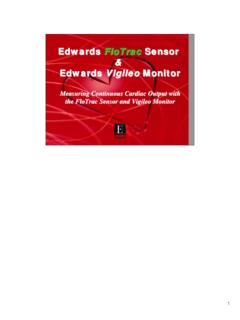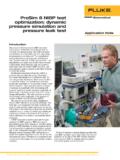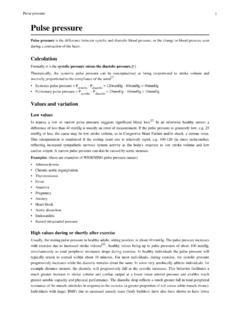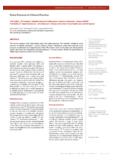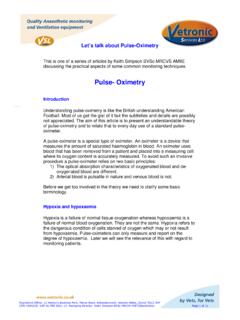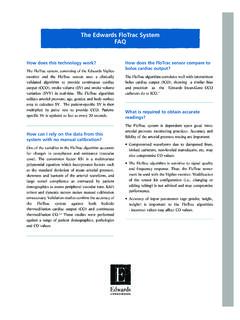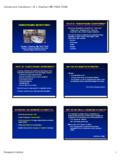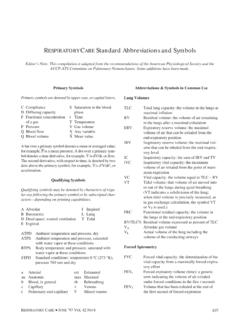Transcription of Arterial Blood Gases, Digital Pulse Oximetry, and …
1 1 Arterial Blood Gases, Digital Pulse oximetry , and Routine Blood Work By John R. Goodman BS RRT Patients with chronic lung disease frequently are tested to determine their lung function. The lungs basically have just two primary functions. That is to transfer oxygen from the air we breathe into the Blood , and to eliminate carbon dioxide from the body. Tests which measure how well your lungs are performing these functions include Pulse oximetry , Arterial Blood gases, specific Blood tests, chest x-rays, and pulmonary function studies. They may be done on a scheduled basis during routine visits to your doctor, or whenever you have symptoms your doctor is concerned about.
2 Let s take a moment to explain why each test is so important. Pulse oximetry : When your doctor, respiratory therapist, or nurse puts a finger Pulse oximeter or perhaps a probe from a different type of oximeter on your finger, they are checking how well saturated your Blood is with oxygen. More specifically, the oximeter reflects how well saturated your Hemoglobin is with oxygen. Hemoglobin is the protein in the red Blood cell that actually carries and delivers the oxygen to all the tissue cells of the body. The average adult has over one trillion (1,000,000,000,000) cells that together make up the body. Each and every one of them needs just the right amount of oxygen to perform their assigned role in the body.
3 If you want to think of your oxygen as an all consume about 250 ml s of oxygen per minute. That s about one shot glass less than a a pint of minute, or 15,000 ml per hour (over 4 gallons of oxygen), or 360,000 ml per day (over 95 gallons)! In people without heart or lung disease, Arterial Blood is over 90% saturated with oxygen while breathing room air. It is somewhat higher at sea level, and slightly lower at higher altitudes, but always over 90%. Your doctor gets concerned when your saturation drops below 90%. For this reason you may be walked while wearing an oximeter to determine what flow rate is required to keep you over 90% with increased activity or exercise.
4 If you have your own oximeter, use it to guide your oxygen therapy. It is far more important to be adequately oxygenated than it is to conserve oxygen. Increase your flow rate with activity to keep your saturations above 90%. Remember, the human body is very smart. It will only use the amount of oxygen it 2 needs from minute to minute. Therefore, there is no real physiologic benefit to keeping your saturations above 97%. In fact, you are probably just wasting oxygen. Some patients like a little oxygen cushion and there is nothing wrong with that. Other patients want to use the lowest liter flow possible to make their portable oxygen source last longer.
5 There is nothing wrong with this approach either, as long as your saturations stay above 90% under conditions of rest and activity. Keeping your saturations in the mid 90 s is probably the best target for all patients. Don t focus on your oxygen flow on your oxygen saturation! The first commercially available oximeter for hospital use (around 1979) cost over $21, , only worked with the old style ear-clip, and was so big it required its own cart to wheel from patient room to patient room. Today s Digital Pulse oximeters are commonly purchased for less than $ on the Internet, yet they utilize the same principle of operation, are much easier to use, and are just as accurate.
6 Technology has indeed come a long way! Over $63, in 2011 dollars Less than $ on the Internet A Few Personal Comments The following comments are my own personal observations and recommendations: While the 90% saturation figure is universally recognized as acceptable , that doesn t mean you should shoot for JUST 90%. I have been asked literally thousands of times over my career what saturations should a particular patient shoot for. I always answer the same. Well, what is a NORMAL oxygen saturation based on the altitude where you live? Here in Denver where the altitude is virtually exactly 5,280 feet, we use the normal range of 94-97% as quite normal and very acceptable.
7 If you live along or near any of our coastlines (sea level) your normals are higher because you are almost literally at sea level. Perhaps a range of 95%-98% would be your normal range. The reason for the difference is due to two values. The first is the percentage of oxygen in the air we all breathe. This one 3 is easy. The percentage of oxygen in room air is just a tick under 21%. We virtually always round up and consider 21% to be that number. Pulmonologists and respiratory therapists know this as the FI02 or Fraction of Inspired Oxygen. The second value we need to know is the barometric pressure. Barometric pressure (Pb) can be measured in several different ways.
8 In pulmonary medicine we use the millimeter (mm) of mercury (Hg) as our reference. At sea level the Pb is normally reported as 760 mm/Hg. For reference, here in Denver, our Pb is normally around 620mm/Hg. Since the FI02 stays exactly the same at 21% up to an altitude of 60 miles, we simply have to multiply the Pb by the FI02 to see the how much oxygen is available for us to breath at any altitude. This is reported as the PI02 or the Pressure of Inspired Oxygen. So 760 x .21= a pressure of just about 160mm/Hg, and here in Denver 620 x .21= about 130mm/Hg. That 30 mm difference can mean a great deal physiologically to patients who require supplemental oxygen.
9 A patient doing well on 2 L/min in Denver, may not need oxygen at all if they travel to Miami. Remember, this is the amount of oxygen in our atmosphere that is available to all of is not the final amount of oxygen that makes it to the lungs. More on these values later, when I talk about Arterial Blood gases. And just for the record, no one can ever have an oxygen saturation of 100% breathing room air anywhere most people live in the United States. I m not sure if oxygen saturation studies have ever been done in Death Valley or the Dead Sea! So the take home lesson t just accept the lowest oxygen saturation commonly used as the 90% point.
10 Try your best to target a normal ! This is especially true under conditions of increased activity, when the cells of your body typically are crying out for more oxygen to do more work. Would you accept one puff of your inhaler when you know it takes two? Oxygen is the most important drug you are taking. Take exactly what you need, exactly when you need it. You will only not feel better; you will function better, and live longer. The beauty of Pulse oximetry is that it is completely non-invasive. Over the past 30+ years, Pulse oximetry has become known as the 5th vital sign. However, even Pulse oximetry is limited in that it only gives information primarily regarding oxygenation status.





